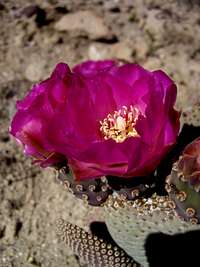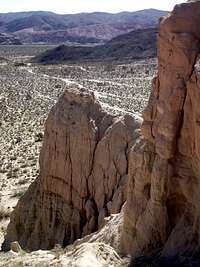|
|
Canyon |
|---|---|
|
|
35.36673°N / 117.98123°W |
|
|
Hiking |
|
|
Spring |
|
|
Overview
Red Rock Canyon State Park features scenic desert cliffs, buttes and spectacular rock formations. The park is located where the southernmost tip of the Sierra Nevada converge with the El Paso Range.The unique and colorful layers of white, pink, red, and brown cliffs grace both the east and west sides of Highway 14. These fluted folds are the result of wind and rain eroding the softer materials beneath the dark cap rocks, which were formed by a harder lava flow layer.
The colorful and scenic cliffs that comprise Red Rock Canyon State Park has been the location of many movies, videos and commercials, including Jurassic Park. In addition, the canyon is considered a wonderful classroom for the study of geology, paleontology and photography as well as an ideal place for family camping and exploration.
Historically, the area was once home to the Kawaiisu Indians, who left petroglyphs in the El Paso mountains and other evidence of their inhabitation. The spectacular gash situated at the western edge of the El Paso mountain range was on the Native American trade route for thousands of years. During the early 1870s, the colorful rock formations in the park served as landmarks for 20-mule team freight wagons that stopped for water. About 1850, it was used by the footsore survivors of the famous Death Valley trek including members of the Arcane and Bennett families along with some of the Illinois Jayhawkers. The park now protects significant paleontology sites and the remains of 1890s-era mining operations, and has been the site for a number of movies.
Natural History
Each tributary canyon is unique, with vivid colors. Natural preserves have been set aside within the park to protect Red Rock's unique vegetation, wildlife and geology. After wet winters, the park's floral displays are stunning with Goldfields, Lupine, Indian Paintbrush, Sand Verbena and 200 other species. Joshua Trees, typical of the sandy, well-drained soils of the higher desert mingle with Cheesebrush, Bursage and Indian Tea. Lower desert Fishook Cactus, Desert Holly, Sagebrush and Saltbush also abound.
Wildlife includes Roadrunners, hawks, lizards, mice and squirrels. Streams and rivers carved the stunning canyons and cliff faces we enjoy today.
Hagen Canyon: The second main site of interest is Hagen Canyon, just south of the Ricardo turn-off - a one mile long side valley with intricately eroded, multi-colored cliffs, washes and mounds, quite similar to the Bisti Badlands of distant New Mexico. The rocks here have various different strata in shades of red, white and grey, and are topped by a band of black lava, each layer having eroded in different ways. Hagen Canyon has a short trail though visitors are encouraged to walk anywhere.
The colorful and scenic cliffs that comprise Red Rock Canyon State Park has been the location of many movies, videos and commercials, including Jurassic Park. In addition, the canyon is considered a wonderful classroom for the study of geology, paleontology and photography as well as an ideal place for family camping and exploration.
Getting There
The park is 25 miles northeast of Mojave on Highway 14, near Cantil. Go west 1/4 mile on Abbott Drive. Signage indicating the turnoff is clearly visible on Highway 14.The park is 120 miles north of Los Angeles, via Interstate 5 and Highway 14.
Things To Do
PicnickingPicnicking is available in designated areas.
Hiking
Hiking is permitted throughout the park, except the Scenic Canyon area during nesting season from February through May. Observe closures along Scenic Cliffs near Iron Canyon during birds of prey cliff-nesting season.
Auto Touring
Vehicular travel is allowed along designated roadways within the park. Off-road vehicles must have a green sticker and must remain on designated roads.
Horseback Riding
Equestrians may ride on horse trails and designated primative roads. A staging area is located in the Red Cliffs parking area and at Dry Horse Camp, south of the main canyon entrance.
Camping
No camping (RVs, tents, trailers, vehicles) is allowed anywhere within the park except Ricardo Campground. The campground is tucked up against the base of dramatic desert cliffs, with 50 primitive campsites, potable water, pit toilets, fire rings, and tables. Bring your own firewood, or purchase it from a ranger or at the visitor center. There are no RV hook-ups or showers. A maximum of 8 people is allowed per site (there are no group sites).Camping is first-come, first served; there is no reservation system. The campground can fill up on weekends in the spring and fall, especially if the weather is nice or on holiday weekends, so arriving on a Thursday evening or Friday morning is recommended.
Camping is $12 per night per site, which includes parking for one vehicle per site, or $10 per night with seniors (62 years old or older). Additional vehicles are $5 each, which includes all OHV, 4x4, and tow vehicles. There is a 30 foot maximum on RVs, and a dump station is available for $5. Self-registration/payment is required before setting up camp or parking. Vehicles (including OHV) must be parked within the rock lined areas provided at each campsite. No horses or livestock allowed in the campground! Quiet hours are 10 pm to 6 am; generators must be off from 8 pm to 10 am.
The day-use parking area, open sunrise to sunset, is $5 per vehicle per day. Overnight parking in the day-use lot is not permitted.








SpiderSavage - May 7, 2008 11:43 pm - Hasn't voted
Near RedrockJust North of Redrock Canyon is Opal Mountain, the nearest high point. It is accessable by a crude road and is excellent on dark nights for Astronomy. Other highlights of this area include numerous 4WD trails to the West East and North. (I do them w/2WD). There are old mines to explore (Ext Dangerous) to the East. Especially dramatic is the Old Dutch Cleanser Mine (see USGS topo maps)(very dangerous). The BLM areas to the East of RRC St Park is a fun area for opal and gem hunting. The badlands there are rich with fossil bone fragments of prehistoric mammals. (Just leave them for others to see, they're not valuable and will just rot in your collection.) If you get to know the area there are also many primitive roadside campsites outside the State Park that are good. Red Rock Canyon and the general area is a rich recreational resource. Use it, treasure it, and go low impact. Please plan to clean up trash if you go into the back road areas. It was abused before it was protected. Here is a link for more on the Natural History: http://members.aol.com/Waucoba7/redrock/redrockfossils.html
tarol - May 10, 2010 5:36 am - Voted 10/10
camping fees have doubled$25/night now!